Hiking to the Sun Gate in Machu Picchu is a memorable experience that will connect you with the beauty of nature.
This amazing place is one of the most remarkable archaeological sites in the world. The Sun Gate, also known as Intipunku in Quechua language, is the entrance to the Inca citadel of Machu Picchu and the end of the Inca Trail.
To reach the Sun Gate or Puerta del Sol in Spanish you have to make a demanding 4 to 5 hour hike, but the reward of reaching the top of the mountain and seeing the entire sanctuary of Machu Picchu is well worth the effort.
What you will find here?
- What is the Sun Gate at Machu Picchu?
- What is the history of the Sun Gate?
- What is the significance of the Sun Gate Machu Picchu?
- Hiking to the Sun Gate from Machu Picchu
- Itinerary: Hiking to the Sun Gate from Machu Picchu
- How to Get to the Sun Gate at Machu Picchu
- Machu Picchu Sun Gate map
- Elevation of Sun Gate at Machu Picchu
- Distance from Machu Picchu to Sun Gate
- Machu Picchu Sun Gate view
- Sun Gate Machu Picchu photos
- Weather Sun Gate at Machu Picchu
- Do You Need a Ticket for the Sun Gate at Machu Picchu?
- When Should You Hike to Inti Punku?
- Sun Gate Hiking Essentials
- Recommendations for the Sun Gate at Machu Picchu
What is the Sun Gate at Machu Picchu?
The Sun Gate, or Intipunku in Quechua, is a significant archaeological feature located at Machu Picchu, the iconic Incan citadel set high in the Andes Mountains of Peru. It serves as the ancient entrance to Machu Picchu for those arriving via the Inca Trail and offers one of the most breathtaking first views of the site for trekkers as they complete their journey.
Intipunku is strategically positioned on a mountain ridge above Machu Picchu and was designed to align with the sun during certain solar events, particularly the summer solstice. As the sun rises, its rays pass through the gate, illuminating the citadel in a spectacular display of architectural and astronomical alignment, showcasing the Inca's advanced understanding of celestial movements.
The Sun Gate likely served both ceremonial and practical purposes. It may have acted as a control point for access to Machu Picchu and as a celestial observatory for the Incas, who revered the sun and integrated solar alignments into many of their constructions.
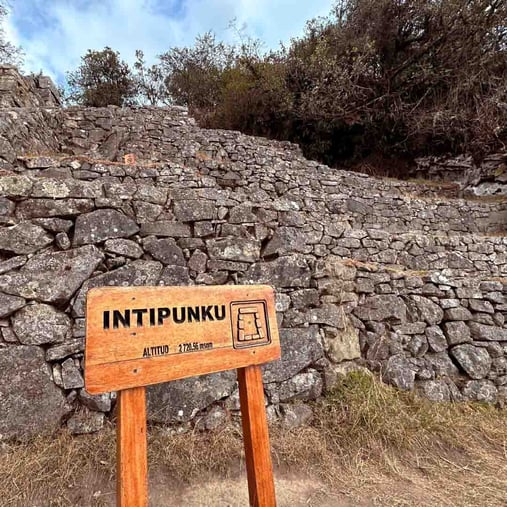
What is the history of the Sun Gate?
The history of the Sun Gate (Intipunku) at Machu Picchu, aligned with key events in the Inca Empire and the subsequent rediscovery of Machu Picchu, unfolds as follows:
Mid-15th Century: Construction of Machu Picchu
- 1438-1472: The reign of Pachacuti, the ninth Sapa Inca of the Inca Empire, marks the beginning of Machu Picchu's construction. Pachacuti is credited with transforming the Kingdom of Cusco into the vast Inca Empire. Machu Picchu, including the Sun Gate, is believed to have been built as a royal estate or a sacred religious site during this period.
Mid-15th Century: The Sun Gate's Role
- The Sun Gate is constructed as part of the Machu Picchu complex. It serves both practical and ceremonial purposes, acting as a checkpoint for entering the city and an astronomical observatory for tracking solar events, particularly the summer solstice.
Late 15th to Early 16th Century: Inca Empire's Height
- The Inca Empire reaches its zenith, with Machu Picchu and the Sun Gate playing significant roles in the spiritual and administrative activities of the empire.
1533: Spanish Conquest
- The Spanish conquistadors arrive in the Inca heartland, leading to the eventual fall of the Inca Empire. Machu Picchu is abandoned, and the Sun Gate, along with the rest of the site, falls into disuse and is gradually reclaimed by the surrounding jungle.
1911: Rediscovery of Machu Picchu
- July 24, 1911: Hiram Bingham, an American historian and explorer, sponsored by Yale University and the National Geographic Society, rediscovers Machu Picchu with the help of local indigenous people. The Sun Gate gains international attention as part of this lost Incan city.
20th Century: Archaeological Studies
- Following its rediscovery, extensive archaeological studies are conducted at Machu Picchu. Researchers strive to understand the purpose and significance of the Sun Gate, analyzing its construction and alignment with celestial events.
21st Century: UNESCO and Tourism
- Machu Picchu, including the Sun Gate, is declared a UNESCO World Heritage Site in 1983, recognized for its historical, cultural, and architectural significance. The site becomes a major tourist destination, with the Sun Gate offering visitors breathtaking views of Machu Picchu and insights into Inca astronomy and engineering.
Today: Preservation Efforts
- Ongoing efforts are made to preserve Machu Picchu and the Sun Gate amid challenges posed by natural erosion and increasing numbers of tourists. The site remains a symbol of Inca ingenuity and a testament to their profound connection with the natural and celestial worlds.
What is the significance of the Sun Gate Machu Picchu?
The Sun Gate (Intipunku) at Machu Picchu holds profound significance, both historically and culturally, as a key component of the Inca Trail and the Machu Picchu sanctuary. Its importance can be understood through several dimensions:
- Astronomical Precision: The Sun Gate showcases the Incas' advanced understanding of astronomy. It is strategically positioned to align with the sun during the summer solstice, allowing the sun's first rays to pass through it and illuminate the Machu Picchu citadel. This alignment highlights the Inca's sophisticated knowledge of celestial movements and their importance in agricultural cycles and religious ceremonies.
- Solar Worship: The Incas were sun worshippers, and the Sun Gate likely played a role in rituals dedicated to Inti, the sun god. Its position and purpose reflect the cultural and religious significance of the sun in Inca society, serving as a symbolic gateway between the earth and the celestial realm.
- Strategic Entrance: For those trekking the Inca Trail, the Sun Gate serves as the first point from which Machu Picchu is visible, acting as a majestic entrance to the site. It symbolizes the end of a journey along the Inca Trail, offering a breathtaking and rewarding view of the citadel.
- Defensive Feature: The gate's elevated position above Machu Picchu could also suggest a strategic defensive role, controlling access to the citadel and providing a lookout point against potential threats.
- Part of a Network: The Sun Gate is an integral part of the network of trails and roads that made up the Qhapaq Ñan, the Inca road system that connected various parts of the empire. Its presence highlights the engineering prowess and the extensive reach of the Inca civilization across diverse terrains.
- Pilgrimage and Rituals: For many, the journey to Machu Picchu via the Sun Gate is considered a modern-day pilgrimage, echoing the possible historical use of the trail and the gate for religious and ceremonial purposes.
- Symbol of Inca Legacy: The gate stands as a testament to the ingenuity and spirituality of the Inca civilization, offering insight into their architecture, astronomical knowledge, and the harmonious integration of their structures with the natural landscape.
- Tourist Attraction: Intipunku remains a significant attraction for visitors to Machu Picchu, providing not only spectacular views but also a moment of reflection on the achievements of the Inca Empire.
Hiking to the Sun Gate from Machu Picchu
Creating an itinerary for a hike to the Sun Gate (Intipunku) from Machu Picchu provides a structured way to enjoy this breathtaking experience. Here’s a suggested route and timeline for a morning hike, aiming to catch the early light over Machu Picchu and avoid the larger crowds that gather later in the day.

Itinerary: Hiking to the Sun Gate from Machu Picchu
Preparation: The Day Before
- Evening: Ensure you have water, snacks, a fully charged camera or smartphone, sun protection (hat, sunscreen), and appropriate clothing for the hike (comfortable hiking shoes, layers for changing weather, rain jacket).
- Accommodation: Stay in Aguas Calientes, the nearest town to Machu Picchu, to get an early start.
Hike Day
6:00 AM: Breakfast
- Start your day with an energizing breakfast in Aguas Calientes. Consider foods high in carbohydrates and proteins to fuel your hike.
6:30 AM: Bus Ride to Machu Picchu
- Catch one of the first buses from Aguas Calientes to Machu Picchu. The bus ride takes about 25-30 minutes.
7:00 AM: Machu Picchu Entrance
- Enter Machu Picchu as it opens. Spend a few moments soaking in the sight of the citadel in the soft morning light.
7:30 AM: Start of Hike to the Sun Gate
- Locate the signposted trail to the Sun Gate, which starts within the Machu Picchu site. The path is well-marked and begins with a gentle ascent.
8:15 AM - 8:30 AM: Arrival at the Sun Gate
- The hike to the Sun Gate takes approximately 45 minutes to an hour. Upon arrival, enjoy the panoramic views of Machu Picchu and the surrounding mountains. This is the perfect time for photography and to appreciate the serenity of the site.
8:30 AM - 9:00 AM: Enjoy the View and Rest
- Take your time to rest and enjoy the views from the Sun Gate. Use this opportunity to hydrate and have a snack.
9:00 AM: Return Hike to Machu Picchu
- Begin your descent back to Machu Picchu. The return hike tends to be quicker but take care on the steps, especially if they are wet.
10:00 AM: Explore Machu Picchu
- After returning to the main site, use the remaining time to explore Machu Picchu’s many sectors and structures. Consider hiring a guide for a deeper understanding of the history and significance of the site.
12:00 PM: Lunch
- Head back to Aguas Calientes for lunch. There are numerous dining options in the town to suit various tastes and budgets.
Afternoon: Return to Cusco or Spend More Time Exploring
- Depending on your schedule, you may choose to return to Cusco in the afternoon or spend more time exploring Aguas Calientes and its surroundings, including the hot springs, museums, or nearby nature walks.
Tips:
- Tickets: Ensure you have your entrance ticket to Machu Picchu and bus tickets (if using the bus service) arranged in advance.
- Water and Snacks: There are no facilities to purchase food or water on the trail or at the Sun Gate, so bring enough to stay hydrated and energized.
- Respect the Site: Stay on the marked paths and follow all regulations to help preserve the integrity of this UNESCO World Heritage Site.
How to Get to the Sun Gate at Machu Picchu
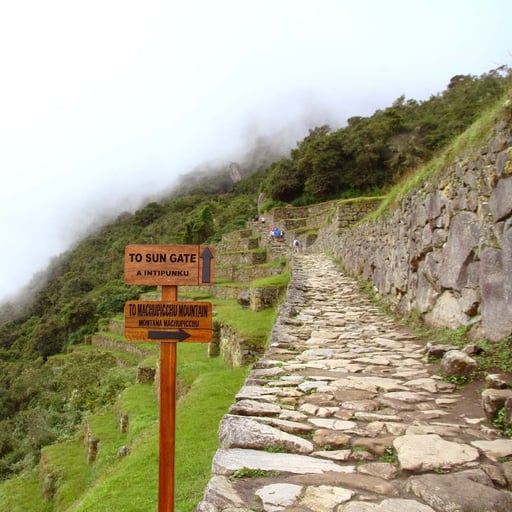
Getting to the Sun Gate (Intipunku) from Machu Picchu involves a relatively straightforward but rewarding hike, which offers some of the most iconic views of the Inca citadel and the surrounding Andean landscape. Here’s a step-by-step guide on how to reach the Sun Gate:
Step 1: Arrive at Machu Picchu
First, you need to get to Machu Picchu itself. This can be done by taking a train from Cusco or Ollantaytambo to Aguas Calientes (also known as Machu Picchu Pueblo), the town located at the base of the mountain.
From Aguas Calientes, you can take a 25-30 minute bus ride up to the Machu Picchu entrance. It's also possible to hike up from Aguas Calientes to Machu Picchu along a steep trail, which takes about 1.5 to 2 hours.
Step 2: Enter Machu Picchu
Upon entering Machu Picchu, you’ll find yourself at the main entrance where tickets are checked.
Make sure you have your ticket ready; tickets must be purchased in advance and have a specific entry time.
Step 3: Begin the Hike to the Sun Gate
- Locate the Trailhead: Inside Machu Picchu, look for signs pointing towards the Sun Gate or ask a staff member for directions. The trailhead is easily accessible from the main site.
- Hiking Trail: The trail to the Sun Gate is a well-marked path that ascends the mountain ridge above Machu Picchu. The hike is approximately 1.5 kilometers (about 0.9 miles) one way and takes between 45 minutes to an hour to complete, depending on your pace.
Step 4: Ascend to the Sun Gate
The hike is of moderate difficulty, with some steep sections and steps. As you ascend, you’ll pass through lush vegetation and may see some of the local wildlife.
The path is relatively straightforward, but it’s important to take your time, especially if you’re not yet acclimatized to the altitude.
Step 5: Enjoy the Views from the Sun Gate
Upon reaching the Sun Gate, you’ll be rewarded with stunning panoramic views of Machu Picchu below and the surrounding mountains.
This is an excellent spot for photography and to take a moment to appreciate the historical and cultural significance of the site.
Machu Picchu Sun Gate map

Elevation of Sun Gate at Machu Picchu
The Sun Gate (Intipunku) at Machu Picchu is situated at an elevation of approximately 2,720 meters (8,924 feet) above sea level.
This elevation provides the Sun Gate with its stunning panoramic views of Machu Picchu and the surrounding Andean landscape, making it a popular destination for visitors looking to capture a classic perspective of the ancient citadel.
Distance from Machu Picchu to Sun Gate
The distance from the main site of Machu Picchu to the Sun Gate (Intipunku) is approximately 1.5 kilometers (about 0.9 miles) along a well-marked hiking trail.
This trail ascends the mountain ridge above Machu Picchu, providing hikers with stunning views of the citadel and the surrounding Andean landscape as they make their way to the Sun Gate.
The hike typically takes about 45 minutes to an hour to complete, depending on the hiker's pace and how often they stop to enjoy the views.
Machu Picchu Sun Gate view
The view from the Sun Gate (Intipunku) of Machu Picchu is one of the most iconic and breathtaking perspectives of the ancient Inca citadel.
As visitors reach the Sun Gate, they are greeted with a panoramic vista that encompasses the entire Machu Picchu complex nestled within the dramatic landscape of the Andes Mountains.
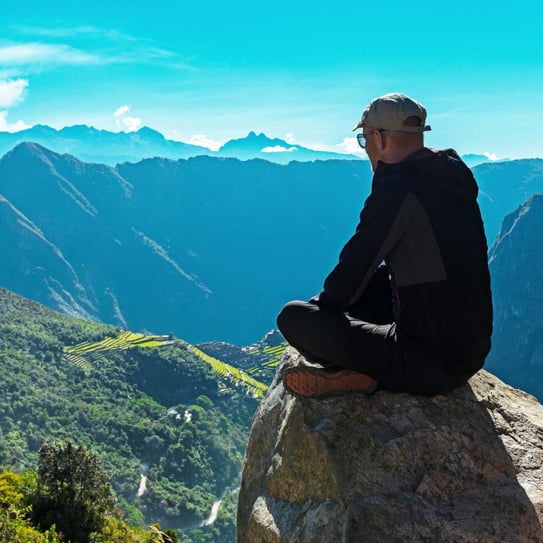
Sun Gate Machu Picchu photos


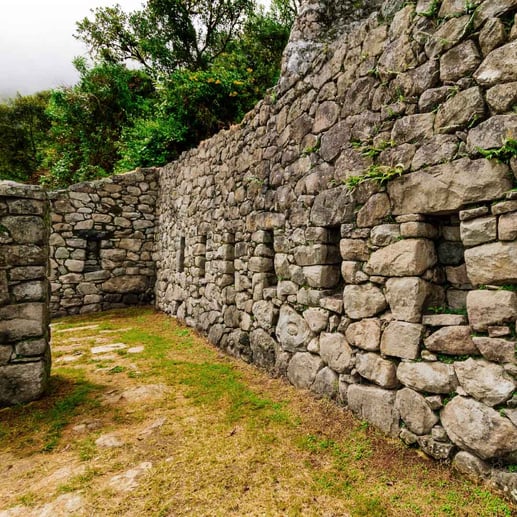
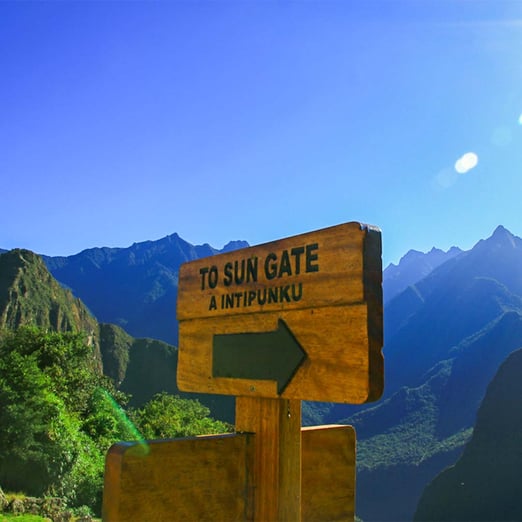
Weather Sun Gate at Machu Picchu
The weather at the Sun Gate (Intipunku) at Machu Picchu, like the rest of the Machu Picchu site, is characterized by a subtropical highland climate. This means that weather conditions can be quite variable and somewhat unpredictable, influenced by both the altitude and the geographical features of the region. Here's what you can generally expect in terms of weather at the Sun Gate:
Dry Season (May to September)
- Conditions: This period offers the clearest skies and the least precipitation, making it the most popular time for visitors. Mornings can be cool, but temperatures typically warm up by midday.
- Temperature: Daytime temperatures can range from 18°C to 25°C (64°F to 77°F), while nights and early mornings can be cooler, sometimes dropping to around 0°C to 5°C (32°F to 41°F).
- Considerations: Despite being the dry season, always prepare for the possibility of rain. Morning fog can also be common, which usually clears up as the day progresses.
Wet Season (October to April)
- Conditions: The wet season brings more frequent and heavier rains, with January and February seeing the highest rainfall. The site can be cloudier during this time, with fog often obscuring views in the mornings or after rainfalls.
- Temperature: Temperatures during the day remain mild, similar to the dry season, but the increased humidity can make it feel warmer. Nights remain cool.
- Considerations: If you're hiking to the Sun Gate during the wet season, waterproof gear is essential. The rain can make the trails slippery, so good hiking shoes with excellent traction are also important.
Do You Need a Ticket for the Sun Gate at Machu Picchu?
No, you do not need a separate ticket specifically for the Sun Gate (Intipunku) at Machu Picchu. Access to the Sun Gate is included with your general admission ticket to Machu Picchu. However, it's important to note the following:
- Machu Picchu Tickets: You must purchase an entrance ticket to Machu Picchu in advance, as the number of visitors is capped daily to protect the site. There are different types of tickets, including those that allow access to Machu Picchu Mountain and Huayna Picchu Mountain, but the basic entrance ticket grants you access to the main archaeological site and the hike to the Sun Gate.
When Should You Hike to Inti Punku?
Hiking to Inti Punku, or the Sun Gate, at Machu Picchu is a memorable experience, offering spectacular views of the ancient Inca citadel and the surrounding landscape. The best time to embark on this hike depends on a few factors, including weather conditions, crowd sizes, and personal preferences:
Best Time of Year
- Dry Season (May to September): This is the most popular time to visit Machu Picchu and hike to the Sun Gate due to the lower likelihood of rain and clearer skies. However, it's also the busiest period, so expect more fellow hikers on the trail. Mornings during these months can offer clear views, but it's advisable to start early to avoid the larger crowds that arrive later in the day.
- Wet Season (October to April): While the wet season sees fewer tourists, the higher chance of rain and cloud cover can make the hike more challenging and potentially obscure the views. However, the landscape is more lush and green during these months, offering its own unique beauty.
Best Time of Day
- Early Morning: Starting your hike early in the morning is highly recommended. Not only will you beat the larger crowds, but you'll also have the chance to see the sunrise illuminate Machu Picchu from the Sun Gate. Morning light provides excellent photo opportunities and a cooler hiking temperature.
- Late Afternoon: Another option is to hike to the Sun Gate in the late afternoon when most visitors are starting to leave the site. While you won't catch the sunrise, the afternoon light and possibly fewer people can make for a peaceful and beautiful experience. However, be mindful of the time, as Machu Picchu has a closing time, and you'll need to start your return hike accordingly.
Sun Gate Hiking Essentials
- Sturdy Hiking Shoes/Boots - With good grip for uneven terrain.
- Water - Adequate supply for hydration.
- Energy-Boosting Snacks - Nuts, fruit, energy bars.
- Sunscreen - High SPF for protection against strong sunlight.
- Hat or Cap - To shield your face from the sun.
- Sunglasses - With UV protection.
- Breathable Clothing - Light and moisture-wicking layers.
- Waterproof Jacket/Poncho - Especially during the wet season.
- Comfortable Backpack - To carry essentials.
- Camera/Smartphone - Fully charged for photos; consider a portable charger.
- Personal Identification - Passport or a copy.
- Basic First Aid Kit - Band-aids, antiseptic wipes, blister plasters, personal medication.
- Insect Repellent - For protection against mosquitoes.
- Map or Guidebook - For additional information about the trail and Machu Picchu.
- Headlamp/Flashlight - If starting early or finishing late.
- Cash - For snacks, water, or souvenirs in Aguas Calientes or Machu Picchu.
- Altitude Sickness Prevention - Medication or natural remedies like coca leaves.
- Toilet Paper and Hand Sanitizer - As facilities are minimal along the trail.
Recommendations for the Sun Gate at Machu Picchu
Visiting the Sun Gate (Inti Punku) at Machu Picchu offers a unique perspective of the ancient citadel and its stunning surroundings. To enhance your experience, consider these recommendations:
Plan Your Visit
- Start Early: Aim to start your hike early in the morning to catch the breathtaking sunrise over Machu Picchu. This also helps you avoid the crowds and enjoy a more serene experience.
- Check Weather and Season: Be aware of the weather conditions and season. The dry season (May to September) offers clearer skies and less rain, making it ideal for hiking.
- Acclimatize: Spend a couple of days in Cusco or the Sacred Valley to adjust to the altitude before attempting the hike to the Sun Gate to minimize the risk of altitude sickness.
What to Bring
- Proper Footwear: Wear sturdy hiking shoes or boots with good grip, as the trail can be rocky and uneven.
- Water and Snacks: Carry enough water to stay hydrated and bring energy-boosting snacks for the hike.
- Sun Protection: The sun can be strong at high altitudes. Bring sunscreen, sunglasses, and a hat.
- Layers: Dress in layers to adapt to changing temperatures throughout the day. Include a lightweight rain jacket or poncho, especially outside the dry season.
- Camera: Don’t forget your camera or smartphone to capture the stunning views from the Sun Gate.
On the Trail
- Take Your Time: The hike is relatively moderate, but altitude can affect your pace. Take breaks as needed and enjoy the scenery.
- Stay on the Path: Preserve the natural and historical environment by staying on the marked trails.
- Respect the Site: Machu Picchu is a UNESCO World Heritage site. Help conserve its beauty for future generations by not littering and following all site regulations.
Safety and Etiquette
- Stay Hydrated: Drink water regularly to avoid dehydration, which can be exacerbated by altitude.
- Respect Others: The Sun Gate and Machu Picchu can be busy, especially during peak tourist season. Be considerate of other visitors, especially when taking photos or stopping to enjoy the views.
- Health Precautions: If you have any health concerns or are prone to altitude sickness, take appropriate precautions, including medication if necessary. Consult with a healthcare provider before your trip.

















